“Malta’s economy growth rises by 9% in the second quarter of 2022“, said Maltese Prime Minister Robert Abela in a tweet.
The provisional estimates of the Malta National Statistics Office reveal that the gross domestic amount (GDP) in the second quarter of 2022 was 4,100.4 million euros, with an increase of 14.7% and therefore of 526.6 million. of euro, compared to the same quarter of 2021, resulting in an increase of 8.9% of GDP.
In the second quarter of 2022, gross value added (GVA) grew by 15% in nominal terms and by 9% in terms of volume.
The activities of industries and services were the drivers of growth of 9%, construction had a minimum significance of 0.2%, while for agriculture and fisheries, the impact on growth was neutral.
In the same quarter of 2021, service and industry activities increased in terms of volume, while there was a decline in fishing, construction and agriculture.
The main driving sectors for the growth of services were: catering and hospitality activities (263.1%), communication and information (15.3%), wholesale and retail trade; transport and storage (16.9%), motorcycle and vehicle repair (14.6%), entertainment (10.1%).
Malta’s economy grows
Net taxes on products contributed to positive GDP growth.
The expenditure approach gives another method for calculating GDP, the result of which is the sum of expenditure for the total consumption of households, institutions serving non-profit households, public administrations, net exports and gross investments.
On the other hand, domestic demand made a contribution to the year-on-year growth rate of GDP with 4.5%, with final consumption expenditure making a positive contribution of 7.5 percentage points, while gross investments had a negative contribution of 3.0 percentage points.
A positive contribution of 4.5% was also recorded by external demand, with 9.9% for exports and 5.5% for imports. Final consumption expenditure recorded a 12.1% increase in volume in the second quarter of 2022, resulting from the increase in household and general government spending.
On the other hand, there was a 12.3% decrease in gross investments in volume, due to investments made for machinery and equipment.
As regards exports and imports, on the other hand, there was an increase of 6.4% and 3.9% respectively.
The third method for measuring economic activity is the income method, which demonstrates the distribution of GDP between wages of employees, taxes on production and imports and the operating surplus of firms. Compared to the second quarter of 2021, the € 526.6 million increase in nominal GDP results from a € 141.9 million increase in employee wages, a € 297.7 million increase in operating margin gross and mixed-income and an increase of 86.9 million euros in net taxation on production and imports.
The PN has made it clear that taking into account Malta’s economy growth, the government must ensure that everyone benefits from it and that for this reason the problem linked to the cost of living will be addressed in the coming months.






